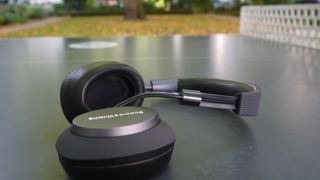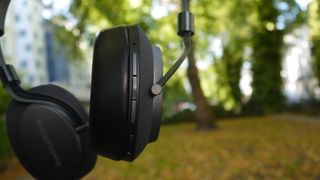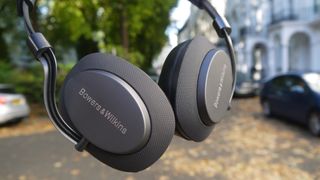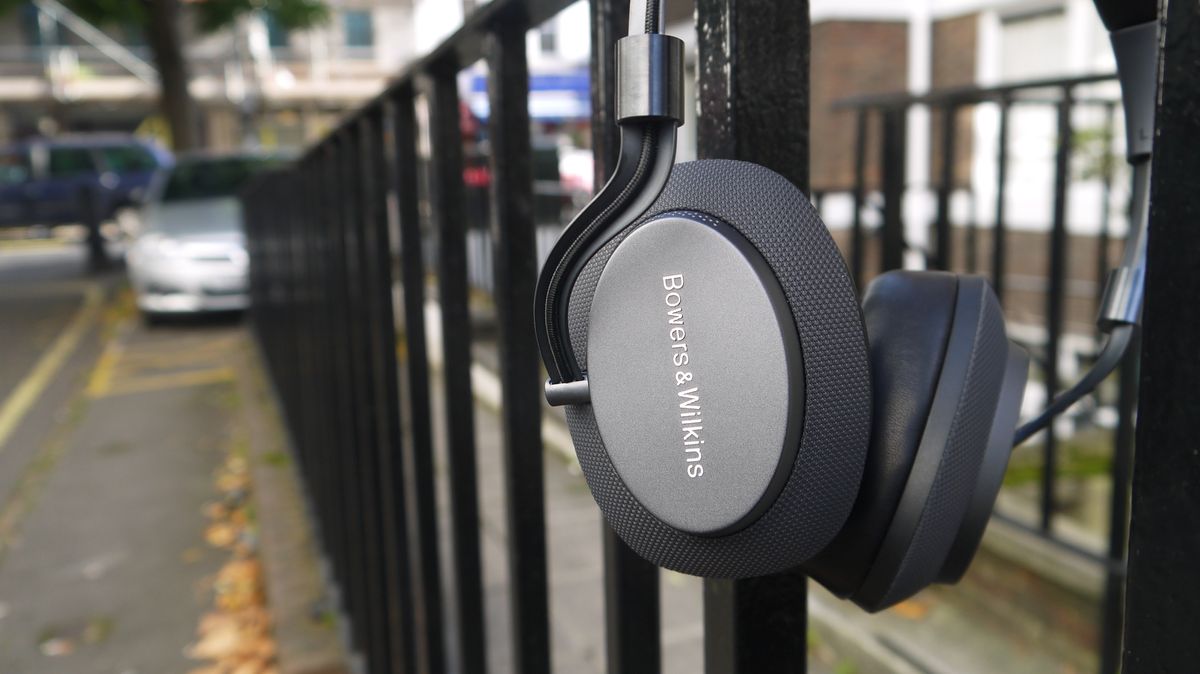TechRadar Verdict
Bowers and Wilkins might be a little late to the noise-cancelling game but, in this regard at least, the wait has been worth it. The noise-cancellation certainly impresses, but what's more surprising is that B&W has built in an innovative sensing system that means the headphones turn off automatically when you're not wearing them. Unfortunately, their sound quality doesn't quite keep pace with their other innovations, leading to a pair of headphones that ultimately falls short of true greatness.
Pros
- +
Noise-cancellation impresses
- +
Auto pause-play works well
- +
USB-C charging
Cons
- -
Sound lacks definition
- -
No classic B&W black leather
Why you can trust TechRadar
Wireless noise-cancelling headphones feel like the pinnacle of headphone technology. It’s here that you’ll find all the major brands really flexing their audio muscles.
Whether it’s Bose with the QC35, Sony with the MDR-1000X, or Sennheiser with its Momentum Wireless, all the big players have a high tech pair of cans to sit at the top of their ranges.
All the big players, that is, except for Bowers and Wilkins. Although the speaker company has put out a number of excellent pairs of headphones in recent years, so far it hasn’t put out any noise-cancelling headphones to compete with its competitors flagships.
The newly unveiled Bowers and Wilkins PX Wireless ($400 / £330) are hence an important pair of headphones for the company. This is the top end of its mainstream range, (with the P9 Signature as its most exclusive, premium pair), and it’s where it gets to show off the best of its tech.
In these terms, the PX Wireless are a massive success. The headline feature, the noise-cancellation, works impressively well, and the headphones are also packed with a host of other features that we hope become industry standards such as sensing when they’re off your head and disconnecting automatically.
But, fundamentally, this functionality appears to have lead to a compromise in B&W’s usual premium sound, which means the PX Wireless aren’t quite as good sounding as the competition at this price point.

Design
It’s not just internally that the PX Wireless are different from what the company has done before – the entire design language of the headphones is completely different.
Gone is the black leather and silver accenting that has become the company’s signature look, and it’s been replaced by a more matte finish that’s a little more plastic in appearance (which is a shame since, we hasten to add, they still feature lots of metal in their construction).
The PX Wireless are available in two color schemes, ‘Space Grey’ or ‘Soft Gold’, and we think the design suits the latter much more than the former. The grey color scheme might be understated, but it feels a little drab compared to the company’s previous efforts.
Thankfully while the look might look a little more understated, the build quality is anything but, with a chunky-yet-sleek construction that feels sturdy in the hand and on the head.
Like many others, the B&W PX Wireless feature a companion app. Here you’ll be able to change the type of noise-cancelling applied, and you can also turn off the wear sensor functionality. Although this latter option is great to have, we were happy to pretty much leave the noise-cancellation settings at their defaults.
The feature-set of the headphones is a master-class in covering all the bases of a modern pair of headphones. Charging by USB-C? Check. A non-proprietary 3.5mm jack? Check. A complete set of physical button controls? Check. A respectable 22 hours of battery life? Check. Bluetooth aptX HD support? Check.
At this point, every pair of wireless noise-cancelling headphones should embrace this standard checklist of features. They’re small touches, but they’ll go a long way to making the headphones as easy to use as possible.
More impressive is the ability of the headphones to understand when you’re using them and when you’re not. After an initial pairing process you’ll be able to turn the headphones on and off simply by taking them on and off. You can even pause them by lifting just one of the earcups off your ear.
It’s a great feature, and definitely helps you to maximise the headphones’ battery life since there’s no chance of you taking them off and forgetting to turn them off.
Occasionally the technology can misfire. There were a couple of moments when we paused our music with the headphones still on our head, only for it to resume playing after a couple of seconds in confusion, but these problems were few and far between, and it’s possible to change the sensitivity of the functionality in the companion app.

Noise-cancelling performance
Considering it’s Bowers and Wilkins’ first attempt at noise-cancellation, it’s perhaps surprising that this functionality is the most impressive part of the headphones.
We tried the PX Wireless on a noisy subway train during rush hour using their default (ie ‘Flight’) noise-cancellation settings and they performed admirably, with a level of cancellation that’s up there with the likes of Bose and Sony.
For those who want a more granular level of control, a companion app allows you to choose between three different noise-cancelling modes, with each designed to cancel and let through certain frequencies more than others.
‘City’, for example, is designed to let through traffic noise so that you can walk the streets while safely wearing the headphones, while ‘Office’ lets through higher-frequency voices so colleagues can talk to you. Finally, ‘Flight’ is focussed on eliminating the low rumble of a plane’s engines.
For the most part we were content to leave the headphones set on ‘Flight’, as this appeared to cancel out the most amount of noise overall. ‘City’ was helpful for occasionally using the headphones while walking out and about, but we left ‘Office’ alone, simply because the sound of our colleagues is exactly what we’re trying to avoid. You mileage may, however, vary.

Sound quality
We love the functionality of the Bower and Wilkins PX Wireless, and its noise-cancellation easily competes with the established players, but its sound quality doesn't quite hit the same highs as we've come to expect from B&W.
The biggest problem is the mids and trebles, which have a fuzziness to them that means complex soundstages can end up feeling a little squashed.
Listen to the likes of Radio Protector by 65daysofstatic and when the song really gets going the headphones make the sound feel messier and noisier than it should be.
Overall this leads to a loss of detail that, while not the worst we've ever experienced, is a step behind what we would have hoped for at this price point.
At the bassier end of the spectrum the PX Wireless fair a great deal better. Play Freeze Me by Death from Above 1979 and its driving bass line is present in spades. It's tight, it's punchy, and its given the space to really hold the song together.
It feels odd to complain too much about the sound quality of the PX Wireless, but its a sign of just how mainstream noise-cancellation technology has become that at this price point we're able to expect a premium sound quality in addition to everything else the headphones offer.

Verdict
Functionally, the PX Wireless are a perfect pair of headphones. Their fit is comfortable, their noise-cancellation is great, and their impressive ability to automatically turn on and off as appropriate should mean that you're able to squeeze every drop out of their reasonable battery life.
But, in their noble effort to offer as much functionality as possible, sound quality has unfortunately been compromised. It's not that it's bad, but in 2017 you can and should expect more from a premium-priced pair of headphones, even if they do come equipped with noise-cancellation.
We now live in a world where a pair of headphones such as the AKG N60AC Wireless can come out at a mid-range price point while offering much the same functionality of the PX Wireless.
So, ultimately, the Bowers and Wilkins PX Wireless are a good pair of headphones, but they're asking price is just a little higher than you'd expect considering their sound quality.
- For our top picks, check out our guide to the best wireless headphones and the best noise-cancelling headphones.
Jon Porter is the ex-Home Technology Writer for TechRadar. He has also previously written for Practical Photoshop, Trusted Reviews, Inside Higher Ed, Al Bawaba, Gizmodo UK, Genetic Literacy Project, Via Satellite, Real Homes and Plant Services Magazine, and you can now find him writing for The Verge.

